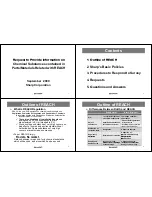
CHAPTER 4.
USING KASPERSKY
ANTI-VIRUS
Kaspersky Anti-Virus allows you to specify the anti-virus protection system of
your computer, at the level either of individual files or of the entire file system.
The application‟s functionality can be packaged into tasks that the administrator
can perform using the application. Tasks implemented using Kaspersky Anti-
Virus can be divided into the following groups:
Updating the anti-virus database, which is used for detecting viruses and
disinfecting infected objects (see 4.1 on p. 20).
Anti-virus protection of the computer‟s file system, using scheduled and/or
on-demand scans (see 4.2 on p. 25).
Real-time anti-virus protection (see 4.3 on p. 31).
This chapter describes these typical tasks. Within the context of a specific
company‟s network, the administrator may combine these tasks and make them
more appropriate to business needs.
4.1.
Updating the anti-virus database
Updating the anti-virus database is performed by the
keepup2date
component,
and is an integral factor in full-fledged anti-virus protection. The default source
used for updating the anti-virus database is Kaspersky Lab‟s updates servers.
The list of these servers includes:
http://downloads1.kaspersky-labs.com/
http://downloads2.kaspersky-labs.com/
ftp://downloads1.kaspersky-labs.com/
, etc.
The list of URL‟s from which you can download the updates is contained in the
updcfg.xml
file, included in the application‟s distribution kit. To view the list of
update servers, enter the following in the command line:
# /opt/kaspersky/kav4ws/bin/kav4ws-keepup2date -s
During the update process, the
keepup2date
component selects the first address
from this list and attempts to download the anti-virus database from the server.
The current computer location (as the two-lettered code of the country according
to the ISO 3166-1 standard) can be specified via the
RegionSettings
parameter
















































